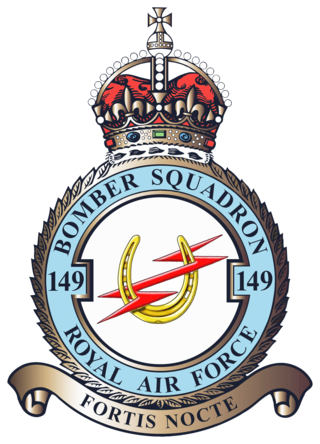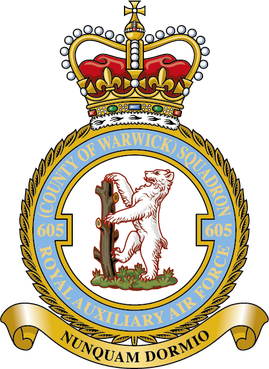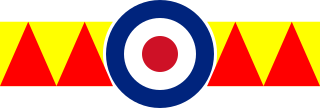
No. 149 Squadron RAF was a Royal Air Force Squadron between 1918 and 1956. Formed 1918 in the Royal Flying Corps as a night-bomber unit, it remained in that role for the rest of its existence which spanned three periods between 1918 and 1956.

No. 21 Squadron of the Royal Air Force was formed in 1915 and was disbanded for the last time in 1979.

No. 40 Squadron of the Royal Air Force was formed in 1916 at Gosport as No. 40 Squadron Royal Flying Corps and was disbanded for the last time in 1957. The squadron also included many non-British members, including volunteers from the Royal Australian Air Force and Royal Canadian Air Force.

No. 504 Squadron was one of the Special Reserve Squadrons of the Auxiliary Air Force, and today is a reserve force of the RAF Regiment. It was integrated into the AAF proper in 1936. Based at RAF Cottesmore, Rutland, 504 Squadron used a variety of light bombers before being re-tasked to fighters with the Hawker Hurricane in 1939. It subsequently became a Fighter Squadron. Currently No. 504 Squadron no longer has a flying role, but as part of No 85 Expeditionary Logistics Wing of the RAF A4 Force.

No. 102 Squadron was a Royal Air Force night bomber squadron in the First World War and a heavy bomber squadron in the Second World War. After the war it flew briefly as a transport squadron before being reformed a light bomber unit with the Second Tactical Air Force within RAF Germany. Its last existence was as a Thor strategic missile unit.
No. 582 Squadron RAF was a bomber pathfinder squadron of the Royal Air Force during the Second World War.
No. 61 Squadron was a squadron of the Royal Air Force. It was first formed as a fighter squadron of the British Royal Flying Corps during the First World War. It was reformed in 1937 as a bomber squadron of the Royal Air Force and served in the Second World War and afterwards into the jet age, until disbanded in 1958.

No. 464 Squadron RAAF is a Royal Australian Air Force (RAAF) unit responsible for public relations. It was originally formed in the United Kingdom during 1942 as a bomber unit. It comprised personnel from Australia, Britain, Canada, New Zealand, South Africa and the Netherlands, the squadron served in the light bomber role, undertaking operations over France and the Low Countries, from bases in England. It also flew night fighter missions. Later, following the Allied invasion of France, the squadron moved to France where it was used to interdict German transports and infrastructure. It further engaged in several low-level precision raids against Gestapo targets in France and Denmark. The squadron was disbanded in September 1945, following the conclusion of the war. No. 464 Squadron was re-formed in January 2021 when the RAAF's public relations functions were transferred from No. 28 Squadron.

No. 500 Squadron AAF was a Royal Air Force flying squadron. It was initially formed in 1931 as a Special Reserve squadron and in 1936 became part of the Auxiliary Air Force, at this time based at Manston and Detling.

No. 613 Squadron was an Auxiliary Air Force later Royal Auxiliary Air Force squadron formed on 1 February 1939 at the then new municipal airport at Ringway, nine miles south of Manchester. The squadron served at first in the army cooperation role, and later during the Second World War became a tactical bomber unit. After the war the squadron reformed as a fighter unit and as such flew until its last disbandment in March 1957.

No. 605 Squadron was formed as an Auxiliary Air Force Squadron. Initially formed as a bomber unit, it became a fighter squadron prior to the Second World War and was one of the most successful participants of the Battle of Britain. It also had the distinction of being active during the war at two fronts at a time, when the squadron was split up between Malta and the Dutch East Indies. In its last incarnation as an active flying unit, the squadron served as the first jet fighter unit in the post-war Royal Auxiliary Air Force; 616 having already flown Gloster Meteors during the war. No. 605 Squadron was reformed as a RAuxAF Logistic Support Squadron (LSS) on 1 Nov 2014 within No. 85 Expeditionary Logistics Wing of the RAF A4 Force. On the 1 January 2019, the Reserve Logistic Support Wing (RLSW) was established with 501, 504 and 605 LSS Squadron's moving from No. 85 Wing RAF to form RLSW.

No. 502 (Ulster) Squadron was a Royal Auxiliary Air Force squadron that saw service in World War II. It was reformed in September 2013, and is the oldest of all the reserve squadrons, being formed in 1925.
No. 58 Squadron was a squadron of the Royal Air Force. For much of its service history in the First and Second World Wars, it operated as a bomber squadron. In the later stages of the Second World War, it was part of Coastal Command and was engaged in anti-submarine patrols.
No. 608 Squadron was an Auxiliary Air Force squadron of the Royal Air Force during the Second World War. It flew during its existence as a bomber, fighter and reconnaissance unit and was the only RAF squadron to be equipped with the unsuccessful Blackburn Botha torpedo bomber.

No. 604 Squadron RAF was a squadron of the Royal Air Force noted for its pioneering role the development of radar-controlled night-fighter operations. The squadron was established in March 1930 at RAF Hendon as a day-bomber squadron of the Royal Auxiliary Air Force. In July 1934, the squadron transitioned to two-seat fighters. Shortly after the commencement of World War II in 1939, the squadron was reassigned to a night-fighter role.
No. 571 Squadron RAF was a Second World War Royal Air Force pathfinder squadron operating the de Havilland Mosquito.

No. 103 Squadron was a Royal Air Force bomber squadron during World War I, World War II and the Cold War, switching to helicopters in the late 1950s until it was disbanded for the last time in 1975.
No. 82 Squadron RAF was a Royal Air Force squadron that was first formed in 1917 and last disbanded in 1963. It served at times as a bomber unit, a reconnaissance unit and lastly as an Intermediate Range Ballistic Missile (IRBM) unit.
No. 107 Squadron RAF was a Royal Flying Corps bomber unit formed during the First World War. It was reformed in the Royal Air Force during the Second World War and was operational during the Cold War on Thor Intermediate Range Ballistic Missiles.
No. 114 Squadron was a squadron of the British Royal Air Force. It was first formed in India during the First World War, serving as a light bomber squadron during the Second World War and as a transport squadron post-war. It was last disbanded in 1971.


















